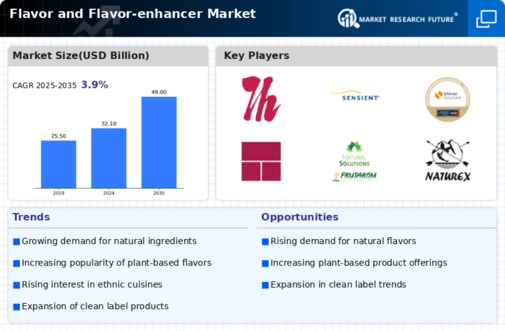Health and Wellness Trends
The Flavor and Flavor-enhancer Market is increasingly shaped by health and wellness trends, as consumers prioritize nutrition and functional benefits in their food choices. There is a growing awareness of the impact of diet on overall health, leading to a demand for flavors that complement healthier options. For instance, the market for low-sugar and low-sodium products is expanding, with consumers seeking flavorful alternatives that do not compromise their health goals. This trend is supported by market data indicating that products marketed as healthy are experiencing a growth rate of approximately 6% annually. As a result, flavor manufacturers are innovating to create enhancers that not only improve taste but also align with health-conscious consumer preferences. This alignment with health trends is likely to drive further growth within the Flavor and Flavor-enhancer Market, as brands strive to meet the evolving demands of health-focused consumers.
Advent of Plant-Based Alternatives
The Flavor and Flavor-enhancer Market is witnessing a surge in demand for plant-based alternatives, driven by the increasing popularity of vegetarian and vegan diets. As consumers become more environmentally conscious and health-oriented, they are seeking flavors that enhance plant-based products. This trend is reflected in market data, which suggests that the plant-based food sector is expected to grow at a compound annual growth rate of 8% over the next five years. Flavor manufacturers are responding by developing innovative flavor enhancers that cater specifically to plant-based offerings, ensuring that these products deliver satisfying taste experiences. This shift not only broadens the appeal of plant-based foods but also presents opportunities for flavor companies to collaborate with food producers in creating unique flavor profiles that resonate with consumers. The advent of plant-based alternatives is likely to play a pivotal role in shaping the future of the Flavor and Flavor-enhancer Market.
Expansion of Food and Beverage Sector
The Flavor and Flavor-enhancer Market is significantly influenced by the expansion of the food and beverage sector. As urbanization and disposable incomes rise, there is a corresponding increase in the demand for diverse food options. This trend is particularly evident in emerging markets, where the food and beverage industry is projected to grow at a rate of 5% annually. The proliferation of restaurants, cafes, and food delivery services has created a fertile ground for flavor innovation, as businesses seek to differentiate their offerings. Additionally, the growing popularity of convenience foods has led to an increased reliance on flavor enhancers to improve taste and appeal. This expansion not only drives sales within the Flavor and Flavor-enhancer Market but also encourages collaboration between flavor manufacturers and food producers to create unique flavor profiles that cater to evolving consumer tastes.
Rising Demand for Clean Label Products
The Flavor and Flavor-enhancer Market is experiencing a notable shift towards clean label products, driven by consumer preferences for transparency and natural ingredients. As consumers become increasingly health-conscious, they seek products that are free from artificial additives and preservatives. This trend is reflected in market data, indicating that the clean label segment is projected to grow at a compound annual growth rate of approximately 7% over the next five years. Manufacturers are responding by reformulating existing products and developing new flavors that align with these consumer demands. This shift not only enhances product appeal but also fosters brand loyalty, as consumers are more likely to choose brands that prioritize clean labeling. Consequently, the Flavor and Flavor-enhancer Market is adapting to these evolving preferences, which may lead to increased competition among manufacturers striving to meet the clean label criteria.
Technological Innovations in Flavor Production
The Flavor and Flavor-enhancer Market is being transformed by technological innovations in flavor production. Advances in extraction and synthesis techniques are enabling manufacturers to create more complex and appealing flavors. Technologies such as molecular gastronomy and flavor encapsulation are gaining traction, allowing for enhanced flavor delivery and stability in various applications. Market data indicates that the adoption of these technologies is expected to increase, with a projected growth rate of 5% in the next few years. This technological evolution not only improves the quality of flavors but also allows for greater customization to meet specific consumer preferences. As a result, flavor manufacturers are better equipped to respond to market demands, leading to a more dynamic and competitive Flavor and Flavor-enhancer Market. The integration of technology into flavor production processes is likely to continue shaping the industry landscape.


















Leave a Comment